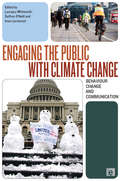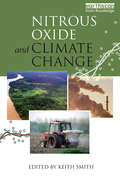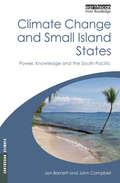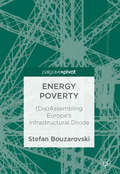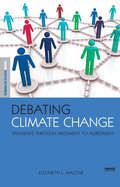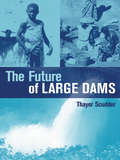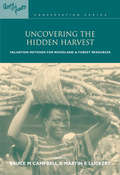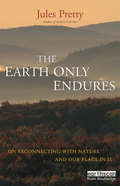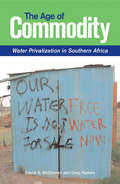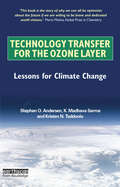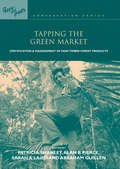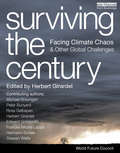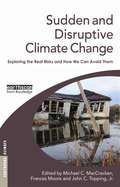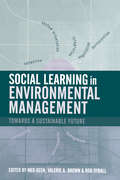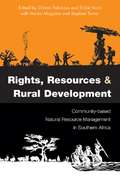- Table View
- List View
Engaging the Public with Climate Change: Behaviour Change and Communication
by Lorraine Whitmarsh Irene Lorenzoni Saffron O'NeillDespite increasing public awareness of climate change, our behaviours relating to consumption and energy use remain largely unchanged. This book answers the urgent call for effective engagement methods to foster sustainable lifestyles, community action, and social change. Written by practitioners and academics, the chapters combine theoretical perspectives with case studies and practical guidance, examining what works and what doesn't, and providing transferable lessons for future engagement approaches. Showcasing innovative thought and approaches from around the world, this book is essential reading for anyone working to foster real and lasting behavioural and social change.
Nitrous Oxide and Climate Change
by Keith SmithNitrous oxide, N2O, is the third most important (in global warming terms) of the greenhouse gases, after carbon dioxide and methane. As this book describes, although it only comprises 320 parts per billion of the earth's atmosphere, it has a so-called Global Warming Potential nearly 300 times greater than that of carbon dioxide. N2O emissions are difficult to estimate, because they are predominantly biogenic in origin. The N2O is formed in soils and oceans throughout the world, by the microbial processes of nitrification and denitrification, that utilise the reactive N compounds ammonium and nitrate, respectively. These forms of nitrogen are released during the natural biogeochemical nitrogen cycle, but are also released by human activity. In fact, the quantity of these compounds entering the biosphere has virtually doubled since the beginning of the industrial age, and this increase has been matched by a corresponding increase in N2O emissions. The largest source is now agriculture, driven mainly by the use of synthetic nitrogen fertilisers. The other major diffuse source derives from release of NOx into the atmosphere from fossil fuel combustion and biomass burning, as well as ammonia from livestock manure. Some N2O also comes directly from combustion, and from two processes in the chemical industry: the production of nitric acid, and the production of adipic acid, used in nylon manufacture. Action is being taken to curb the industrial point-source emissions of N2O, but measures to limit or reduce agricultural emissions are inherently more difficult to devise. As we enter an era in which measures are being explored to reduce fossil fuel use and/or capture or sequester the CO2 emissions from the fuel, it is likely that the relative importance of N2O in the 'Kyoto basket' of greenhouse gases will increase, because comparable mitigation measures for N2O are inherently more difficult, and because expansion of the land area devoted to crops, to feed the increasing global population and to accommodate the current development of biofuels, is likely to lead to an increase in N fertiliser use, and thus N2O emission, worldwide. The aim of this book is to provide a synthesis of scientific information on the primary sources and sinks of nitrous oxide and an assessment of likely trends in atmospheric concentrations over the next century and the potential for mitigation measures.
Nitrous Oxide and Climate Change
by Keith SmithNitrous oxide, N2O, is the third most important (in global warming terms) of the greenhouse gases, after carbon dioxide and methane. As this book describes, although it only comprises 320 parts per billion of the earth's atmosphere, it has a so-called Global Warming Potential nearly 300 times greater than that of carbon dioxide. N2O emissions are difficult to estimate, because they are predominantly biogenic in origin. The N2O is formed in soils and oceans throughout the world, by the microbial processes of nitrification and denitrification, that utilise the reactive N compounds ammonium and nitrate, respectively. These forms of nitrogen are released during the natural biogeochemical nitrogen cycle, but are also released by human activity. In fact, the quantity of these compounds entering the biosphere has virtually doubled since the beginning of the industrial age, and this increase has been matched by a corresponding increase in N2O emissions. The largest source is now agriculture, driven mainly by the use of synthetic nitrogen fertilisers. The other major diffuse source derives from release of NOx into the atmosphere from fossil fuel combustion and biomass burning, as well as ammonia from livestock manure. Some N2O also comes directly from combustion, and from two processes in the chemical industry: the production of nitric acid, and the production of adipic acid, used in nylon manufacture. Action is being taken to curb the industrial point-source emissions of N2O, but measures to limit or reduce agricultural emissions are inherently more difficult to devise. As we enter an era in which measures are being explored to reduce fossil fuel use and/or capture or sequester the CO2 emissions from the fuel, it is likely that the relative importance of N2O in the 'Kyoto basket' of greenhouse gases will increase, because comparable mitigation measures for N2O are inherently more difficult, and because expansion of the land area devoted to crops, to feed the increasing global population and to accommodate the current development of biofuels, is likely to lead to an increase in N fertiliser use, and thus N2O emission, worldwide. The aim of this book is to provide a synthesis of scientific information on the primary sources and sinks of nitrous oxide and an assessment of likely trends in atmospheric concentrations over the next century and the potential for mitigation measures.
Climate Change and Small Island States: Power, Knowledge and the South Pacific
by John Campbell Jon BarnettSmall Island Developing States are often depicted as being among the most vulnerable of all places to the effects of climate change, and they are a cause c?l?bre of many involved in climate science, politics and the media. Yet while small island developing states are much talked about, the production of both scientific knowledge and policies to protect the rights of these nations and their people has been remarkably slow. This book is the first to apply a critical approach to climate change science and policy processes in the South Pacific region. It shows how groups within politically and scientifically powerful countries appropriate the issue of island vulnerability in ways that do not do justice to the lives of island people. It argues that the ways in which islands and their inhabitants are represented in climate science and politics seldom leads to meaningful responses to assist them to adapt to climate change. Throughout, the authors focus on the hitherto largely ignored social impacts of climate change, and demonstrate that adaptation and mitigation policies cannot be effective without understanding the social systems and values of island societies.
Climate Change and Small Island States: Power, Knowledge and the South Pacific
by John Campbell Jon BarnettSmall Island Developing States are often depicted as being among the most vulnerable of all places to the effects of climate change, and they are a cause c?l?bre of many involved in climate science, politics and the media. Yet while small island developing states are much talked about, the production of both scientific knowledge and policies to protect the rights of these nations and their people has been remarkably slow. This book is the first to apply a critical approach to climate change science and policy processes in the South Pacific region. It shows how groups within politically and scientifically powerful countries appropriate the issue of island vulnerability in ways that do not do justice to the lives of island people. It argues that the ways in which islands and their inhabitants are represented in climate science and politics seldom leads to meaningful responses to assist them to adapt to climate change. Throughout, the authors focus on the hitherto largely ignored social impacts of climate change, and demonstrate that adaptation and mitigation policies cannot be effective without understanding the social systems and values of island societies.
Energy Poverty: (Dis)Assembling Europe's Infrastructural Divide
by Stefan BouzarovskiThis open access book aims to consolidate and advance debates on European and global energy poverty by exploring the political and infrastructural drivers and implications of the condition across a variety of spatial scales. It highlights the need for a geographical conceptualization of the different ways in which household-level energy deprivation both influences and is contingent upon disparities occurring at a wider range of spatial scales. There is a strong focus on the relationships among energy transformation, institutional change and place-based factors in determining the nature and location of energy-related injustices. The book also explores how patterns and structures of energy poverty have changed over time, as evidenced by some of the common measures used to describe the condition. In part, this means investigating the makeup of energy poor demographics across various social and spatial cleavages. More broadly, it also argues that energy sector reconfigurations are both reflected in and shaped by various domains of social and political organization, especially in terms of creating poverty-relevant outcomes.
Energy Poverty: (Dis)Assembling Europe's Infrastructural Divide
by Stefan BouzarovskiThis open access book aims to consolidate and advance debates on European and global energy poverty by exploring the political and infrastructural drivers and implications of the condition across a variety of spatial scales. It highlights the need for a geographical conceptualization of the different ways in which household-level energy deprivation both influences and is contingent upon disparities occurring at a wider range of spatial scales. There is a strong focus on the relationships among energy transformation, institutional change and place-based factors in determining the nature and location of energy-related injustices. The book also explores how patterns and structures of energy poverty have changed over time, as evidenced by some of the common measures used to describe the condition. In part, this means investigating the makeup of energy poor demographics across various social and spatial cleavages. More broadly, it also argues that energy sector reconfigurations are both reflected in and shaped by various domains of social and political organization, especially in terms of creating poverty-relevant outcomes.
Debating Climate Change: Pathways through Argument to Agreement
by Elizabeth L MaloneAs greenhouse gas emissions continue unabated and contentious voices fill the air, the question gains urgency: How can people with widely varying viewpoints agree to address climate change? Each participant in the debate seems to have a different agenda, from protecting economic growth in developing countries to protecting the energy industry in industrialized countries, from those aghast at the damage done to the Earth to optimists who think we just need to adjust our technological approach. Debating Climate Change sorts through the tangle of arguments surrounding climate change to find paths to unexpected sites of agreement. Using an innovative sociological approach - combined discourse and social network analyses - Elizabeth L. Malone analyzes 100 documents representing a range of players in this high-stakes debate. Through this she shows how even the most implacable adversaries can find common ground - and how this common ground can be used to build agreement. Written in a clear, accessible style, this original research and insightful use of communication analysis will help advance understanding and negotiation on climate change throughout the pivotal times to come. Published with Science in Society
Debating Climate Change: Pathways through Argument to Agreement
by Elizabeth L MaloneAs greenhouse gas emissions continue unabated and contentious voices fill the air, the question gains urgency: How can people with widely varying viewpoints agree to address climate change? Each participant in the debate seems to have a different agenda, from protecting economic growth in developing countries to protecting the energy industry in industrialized countries, from those aghast at the damage done to the Earth to optimists who think we just need to adjust our technological approach. Debating Climate Change sorts through the tangle of arguments surrounding climate change to find paths to unexpected sites of agreement. Using an innovative sociological approach - combined discourse and social network analyses - Elizabeth L. Malone analyzes 100 documents representing a range of players in this high-stakes debate. Through this she shows how even the most implacable adversaries can find common ground - and how this common ground can be used to build agreement. Written in a clear, accessible style, this original research and insightful use of communication analysis will help advance understanding and negotiation on climate change throughout the pivotal times to come. Published with Science in Society
The Future of Large Dams: "Dealing with Social, Environmental, Institutional and Political Costs"
by Thayer Ted ScudderViewed by some as symbols of progress and by others as inherently flawed, large dams remain one of the most contentious development issues on Earth. Building on the work of the now defunct World Commission on Dams, Thayer Scudder wades into the debate with unprecedented authority. Employing the Commission's Seven Strategic priorities, Scudder charts the 'middle way' forward by examining the impacts of large dams on ecosystems, societies and political economies. He also analyses the structure of the decision-making process for water resource development and tackles the highly contentious issue of dam-induced resettlement, illuminated by a statistical analysis of 50 cases.
Uncovering the Hidden Harvest: Valuation Methods for Woodland and Forest Resources
by Martin K Luckert Bruce M CampbellForests and woodlands provide an enormous range of goods and services to society, from timber and firewood to medicinal plants, watershed protection, destinations for tourists and sacred sites. Only when these are understood and valued can forests and their resources be properly managed and conserved. This work shows how the complicated network of benefits can be untangled and sets out the different approaches needed to value them. It covers the analysis of plant-based markets, non-market valuation and decision frameworks such as cost-benefit analysis.
Uncovering the Hidden Harvest: Valuation Methods for Woodland and Forest Resources
by Martin K Luckert Bruce M CampbellForests and woodlands provide an enormous range of goods and services to society, from timber and firewood to medicinal plants, watershed protection, destinations for tourists and sacred sites. Only when these are understood and valued can forests and their resources be properly managed and conserved. This work shows how the complicated network of benefits can be untangled and sets out the different approaches needed to value them. It covers the analysis of plant-based markets, non-market valuation and decision frameworks such as cost-benefit analysis.
The Earth Only Endures: On Reconnecting with Nature and Our Place in It
by Jules PrettyFor most of human history, we have lived our daily lives in a close relationship with the land. Yet now, for the first time, more people are living in urban rather than rural areas, bringing about an estrangement. This book, by acclaimed author Jules Pretty, is fundamentally about our relationship with nature, animals and places. A series of interlinked essays leads readers on a voyage that weaves through the themes of connection and estrangement between humans and nature. The journey shows how our modern lifestyles and economies would need six or eight Earths if the entire world?s population adopted our profligate ways. Pretty shows that we are rendering our own world inhospitable and so risk losing what it means to be human: unless we make substantial changes, Gaia threatens to become Grendel. Ultimately, however, the book offers glimpses of an optimistic future for humanity, in the very face of climate change and pending global environmental catastrophe.
The Earth Only Endures: On Reconnecting with Nature and Our Place in It
by Jules PrettyFor most of human history, we have lived our daily lives in a close relationship with the land. Yet now, for the first time, more people are living in urban rather than rural areas, bringing about an estrangement. This book, by acclaimed author Jules Pretty, is fundamentally about our relationship with nature, animals and places. A series of interlinked essays leads readers on a voyage that weaves through the themes of connection and estrangement between humans and nature. The journey shows how our modern lifestyles and economies would need six or eight Earths if the entire world?s population adopted our profligate ways. Pretty shows that we are rendering our own world inhospitable and so risk losing what it means to be human: unless we make substantial changes, Gaia threatens to become Grendel. Ultimately, however, the book offers glimpses of an optimistic future for humanity, in the very face of climate change and pending global environmental catastrophe.
The Age of Commodity: Water Privatization in Southern Africa
by David McDonald Greg RuitersAs globalization and market liberalization march forward unabated the global commons continue to be commodified and privatized at a rapid pace. In this global process, the ownership, sale and supply of water is increasingly a flashpoint for debates and conflict over privatization, and nowhere is the debate more advanced or acute than in Southern Africa. The Age of Commodity provides an overview of the debates over water in the region including a conceptual overview of water 'privatization', how it relates to human rights, macro-economic policy and GATS. The book then presents case studies of important water privatization initiatives in the region, drawing out crucial themes common to water privatization debates around the world including corruption, gender equity and donor conditionalities. This book is powerful and necessary reading in our new age of commodity.
Technology Transfer for the Ozone Layer: Lessons for Climate Change
by Stephen O. Andersen K. Madhava Sarma Kristen N. Taddonio'Imagine the pride of earning the Nobel Prize for warning that CFCs were destroying the ozone layer. Then imagine that citizens, policymakers, and business executives heeded the warning and transformed markets to protect the earth. This book is the story of why we can all be optimistic about the future if we are willing to be brave and dedicated world citizens.' MARIO MOLINA, Nobel Laureate in Chemistry and Professor, University of California This book tells how the Montreal Protocol, the most successful global environmental agreement so far, stimulated the development and worldwide transfer of technologies to protect the ozone layer.Technology transfer is the crux of the 230 international environmental treaties and is essential to fighting climate change. While debate rages about obstacles to technology transfer, until now there has been no comprehensive assessment of what actually works to remove the obstacles. The authors, leaders in the field, assess over 1000 technology transfer projects funded under the Montreal Protocol?s Multilateral Fund and the Global Environment Facility, and identify lessons that can be applied to technology transfer for climate change.
Technology Transfer for the Ozone Layer: Lessons for Climate Change
by Stephen O. Andersen K. Madhava Sarma Kristen N. Taddonio'Imagine the pride of earning the Nobel Prize for warning that CFCs were destroying the ozone layer. Then imagine that citizens, policymakers, and business executives heeded the warning and transformed markets to protect the earth. This book is the story of why we can all be optimistic about the future if we are willing to be brave and dedicated world citizens.' MARIO MOLINA, Nobel Laureate in Chemistry and Professor, University of California This book tells how the Montreal Protocol, the most successful global environmental agreement so far, stimulated the development and worldwide transfer of technologies to protect the ozone layer.Technology transfer is the crux of the 230 international environmental treaties and is essential to fighting climate change. While debate rages about obstacles to technology transfer, until now there has been no comprehensive assessment of what actually works to remove the obstacles. The authors, leaders in the field, assess over 1000 technology transfer projects funded under the Montreal Protocol?s Multilateral Fund and the Global Environment Facility, and identify lessons that can be applied to technology transfer for climate change.
Tapping the Green Market: Management and Certification of Non-timber Forest Products
by Abraham Guillen Sarah A Laird Alan R Pierce Patricia ShanleyThere is a rapidly growing interest in, and demand for, non-timber forest products (NTFPs). They provide critical resources across the globe fulfilling nutritional, medicinal, financial and cultural needs. However, they have been largely overlooked in mainstream conservation and forestry politics. This volume explains the use and importance of certification and eco-labelling for guaranteeing best management practices of non-timber forest products in the field. Using extensive case studies and global profiles of non-timber forest products, this work not only seeks to further our comprehension of certification processes but also broaden understanding of non-timber forest product management, harvesting and marketing. It should be useful to forest managers, policy-makers and conservation organizations as well as for academics in these areas.
Surviving the Century: Facing Climate Chaos and Other Global Challenges
by Herbert Girardet'The combined analysis presented here of why current arrangements are failing the future and clear insights of the way to go, offer us hope.' Mary Robinson, President of Realising Rights, Ethical Globalisation Initiative, and former President of Ireland and United Nations High Commissioner for Human Rights Environmental and human catastrophe looms ever larger for planet Earth. Powerful action is required now to turn a deepening global crisis into an unprecedented opportunity for positive change. This book shows how a dramatic transformation of how humans relate to the Earth, and to one another, can be achieved. Surviving the Century is the first major publication by the World Future Council (WFC), a new international voice for future generations. Reflecting the positive mission of the WFC, each chapter addresses a different critical issue in a systematic and constructive way, describing and analysing the topic before indicating real solutions. The eight main issues covered are: countering climate chaos, renewable energy policy, local farming systems, rainforests and climate change, creating sustainable cities, cradle to cradle production systems, a radical vision for trade and creating a living democracy. Surviving the Century is a must-have primer and action plan for all leaders in government, business and NGOs, and for all who want to be part of the historic opportunity to provide solutions to the greatest challenge humanity has ever faced. Published with the World Future Council.
Surviving the Century: Facing Climate Chaos and Other Global Challenges
by Herbert Girardet'The combined analysis presented here of why current arrangements are failing the future and clear insights of the way to go, offer us hope.' Mary Robinson, President of Realising Rights, Ethical Globalisation Initiative, and former President of Ireland and United Nations High Commissioner for Human Rights Environmental and human catastrophe looms ever larger for planet Earth. Powerful action is required now to turn a deepening global crisis into an unprecedented opportunity for positive change. This book shows how a dramatic transformation of how humans relate to the Earth, and to one another, can be achieved. Surviving the Century is the first major publication by the World Future Council (WFC), a new international voice for future generations. Reflecting the positive mission of the WFC, each chapter addresses a different critical issue in a systematic and constructive way, describing and analysing the topic before indicating real solutions. The eight main issues covered are: countering climate chaos, renewable energy policy, local farming systems, rainforests and climate change, creating sustainable cities, cradle to cradle production systems, a radical vision for trade and creating a living democracy. Surviving the Century is a must-have primer and action plan for all leaders in government, business and NGOs, and for all who want to be part of the historic opportunity to provide solutions to the greatest challenge humanity has ever faced. Published with the World Future Council.
Sudden and Disruptive Climate Change: Exploring the Real Risks and How We Can Avoid Them
by Michael MacCracken'An impressive accomplishment.? Al Gore, Former Vice President of the US, co-recipient of the 2007 Nobel Peace Prize, and author of An Inconvenient Truth ?Offers positive solutions that no rational person, organization or government can ignore - except at their peril.? Stephen H. Schneider, Professor for Interdisciplinary Environmental Studies, Stanford University, and author of The Genesis Strategy: Climate and Global Survival ?The science is clear and the message of this book is that there is no more time for delay.? Rosina M. Bierbaum, Dean, University of Michigan While changes in emissions and atmospheric concentrations of greenhouse gases are projected to be slow and smooth, the intensity and impacts of climate change on the environment and society could be abrupt and erratic. Surprising and nonlinear responses are likely to occur as warming exceeds certain thresholds, inducing relatively rapid and disruptive changes in the Greenland and West Antarctic ice sheets, precipitation intensity and patterns, coastal inundation, the occurrence of wildfire, the ranges of plant and animal species and more. Written by a transdisciplinary group of internationally respected researchers, this book explores the possibilities of such changes, their significance for society and efforts to move more rapidly to limit climate change than current government measures.
Sudden and Disruptive Climate Change: Exploring the Real Risks and How We Can Avoid Them
by Michael MacCracken'An impressive accomplishment.? Al Gore, Former Vice President of the US, co-recipient of the 2007 Nobel Peace Prize, and author of An Inconvenient Truth ?Offers positive solutions that no rational person, organization or government can ignore - except at their peril.? Stephen H. Schneider, Professor for Interdisciplinary Environmental Studies, Stanford University, and author of The Genesis Strategy: Climate and Global Survival ?The science is clear and the message of this book is that there is no more time for delay.? Rosina M. Bierbaum, Dean, University of Michigan While changes in emissions and atmospheric concentrations of greenhouse gases are projected to be slow and smooth, the intensity and impacts of climate change on the environment and society could be abrupt and erratic. Surprising and nonlinear responses are likely to occur as warming exceeds certain thresholds, inducing relatively rapid and disruptive changes in the Greenland and West Antarctic ice sheets, precipitation intensity and patterns, coastal inundation, the occurrence of wildfire, the ranges of plant and animal species and more. Written by a transdisciplinary group of internationally respected researchers, this book explores the possibilities of such changes, their significance for society and efforts to move more rapidly to limit climate change than current government measures.
Social Learning in Environmental Management: Towards a Sustainable Future
by Rob Dyball Meg KeenSocial Learning in Environmental Management explores and expands the approaches to collective learning most needed to help individuals, communities, experts and governments work together to achieve greater social and ecological sustainability. It provides practical frameworks and case studies to assist environmental managers in building partnerships that can support learning and action on issues arising from human impacts on the life-support systems of our planet. In this book, social learning frameworks and case studies address the three areas of collaboration, community, government and professional, in some detail. The resulting guidelines and their practical applications provide key source material for undergraduate and postgraduate professional education in the fields of social and environmental sciences, political science, planning, geography and urban studies, and also for professionals in environmental management.
Social Learning in Environmental Management: Towards a Sustainable Future
by Rob Dyball Meg KeenSocial Learning in Environmental Management explores and expands the approaches to collective learning most needed to help individuals, communities, experts and governments work together to achieve greater social and ecological sustainability. It provides practical frameworks and case studies to assist environmental managers in building partnerships that can support learning and action on issues arising from human impacts on the life-support systems of our planet. In this book, social learning frameworks and case studies address the three areas of collaboration, community, government and professional, in some detail. The resulting guidelines and their practical applications provide key source material for undergraduate and postgraduate professional education in the fields of social and environmental sciences, political science, planning, geography and urban studies, and also for professionals in environmental management.
Rights Resources and Rural Development: Community-based Natural Resource Management in Southern Africa
by Christo Fabricius Eddie Koch Stephen Turner Hector MagomeCommunity-based natural resource management (CBNRM) is an approach that offers multiple related benefits: securing rural livelihoods; ensuring careful conservation and management of biodiversity and other resources; and empowering communities to manage these resources sustainably. Recently, however, the CBNRM concept has attracted criticism for failing in its promise of delivering significant local improvements and conserving biodiversity in some contexts. This book identifies the flaws in its application, which often have been swept under the carpet by those involved in the initiatives. The authors analyse them, and propose remedies for specific circumstances based on the lessons learned from CBNRM experience in southern Africa over more than a decade. The result is essential reading for all researchers, observers and practitioners who have focused on CBNRM in sustainable development programmes as a means to overcome poverty and conserve ecosystems in various parts of the globe. It is a vital tool in improving their methods and performance. In addition, academics, students and policy-makers in natural resource management, resource economics, resource governance and rural development will find it a very valuable and instructive resource.
